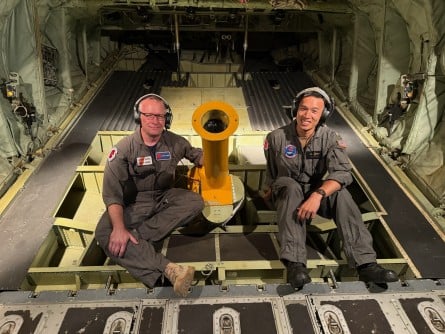Science
New Initiative Enhances Hurricane Forecasting Through Ocean Data

Researchers at the Woods Hole Oceanographic Institution (WHOI) are launching a significant initiative aimed at improving predictions of hurricanes and other extreme weather events. The program, known as the Study on Air-Sea Coupling with Waves, Turbulence, and Clouds at High Winds (SASCWATCH), is set to commence in coordination with the Office of Naval Research and will span three years. This initiative focuses on deploying a grid of ocean sensors in anticipation of hurricanes to enhance understanding of the complex interactions occurring between the ocean and atmosphere.
The SASCWATCH initiative aims to enhance data collection through a combination of in situ observations, satellite data, and high-resolution modeling. This approach helps address previous gaps in knowledge regarding air-sea interactions, which play a crucial role in determining the timing, location, and intensity of severe weather events. Despite the growing recognition of these interconnected factors, they have often been studied in isolation, creating an incomplete understanding of phenomena like hurricanes.
According to Steven Jayne, a physical oceanographer at WHOI and principal investigator of the SASCWATCH program, “This fragmented approach has led to an incomplete picture of how key factors, such as surface waves, ocean currents, and atmospheric turbulence, modulate fluxes under high-wind conditions.” The new program aims to capture these interactions in real time, providing a more comprehensive understanding of how hurricanes develop.
As part of this initiative, Jayne, who also serves as a member of the U.S. Air Force Reserve’s Hurricane Hunters, will utilize advanced ocean monitoring tools. His lab employs two types of ocean robots, the Argo floats and the Air-Launched Autonomous Micro Observer (ALAMO). The Argo floats are deployed from ships and gather temperature and salinity data at various depths every ten days. Currently, there are over 4,000 Argo floats operating worldwide, monitoring the upper 2,000 meters of the ocean and transmitting data back to shore to improve hurricane forecasts.
During hurricane season, data transmission from these floats increases in frequency to provide near-real-time information. The ALAMO, a smaller profiling float, can be deployed from aircraft, allowing for rapid response in the field. Jayne emphasizes that these smaller devices are particularly advantageous for studying short-term weather phenomena, such as hurricanes, as they can be deployed quickly and efficiently.
This initiative marks a pivotal step in advancing our understanding of hurricanes and their underlying mechanisms. By integrating innovative technology with rigorous scientific research, the SASCWATCH program aims to enhance the accuracy of hurricane forecasts, ultimately contributing to better preparedness and response strategies.
As the Woods Hole Oceanographic Institution continues to lead in marine research and exploration, it remains committed to understanding the ocean’s role in the global environment. Established in 1930, WHOI is recognized for its multidisciplinary approach and advanced capabilities in ocean observation. The institution collaborates on over 800 concurrent projects worldwide, striving to push the boundaries of knowledge that inform public policy and promote a healthier planet. For more information on their initiatives, visit whoi.edu.
-

 Lifestyle3 months ago
Lifestyle3 months agoLibraries Challenge Rising E-Book Costs Amid Growing Demand
-

 Sports3 months ago
Sports3 months agoTyreek Hill Responds to Tua Tagovailoa’s Comments on Team Dynamics
-

 Sports3 months ago
Sports3 months agoLiverpool Secures Agreement to Sign Young Striker Will Wright
-

 Lifestyle3 months ago
Lifestyle3 months agoSave Your Split Tomatoes: Expert Tips for Gardeners
-

 Lifestyle3 months ago
Lifestyle3 months agoPrincess Beatrice’s Daughter Athena Joins Siblings at London Parade
-

 World3 months ago
World3 months agoWinter Storms Lash New South Wales with Snow, Flood Risks
-

 Science3 months ago
Science3 months agoTrump Administration Moves to Repeal Key Climate Regulation
-

 Science2 months ago
Science2 months agoSan Francisco Hosts Unique Contest to Identify “Performative Males”
-

 Business3 months ago
Business3 months agoSoFi Technologies Shares Slip 2% Following Insider Stock Sale
-

 Science3 months ago
Science3 months agoNew Tool Reveals Link Between Horse Coat Condition and Parasites
-

 Sports3 months ago
Sports3 months agoElon Musk Sculpture Travels From Utah to Yosemite National Park
-

 Science3 months ago
Science3 months agoNew Study Confirms Humans Transported Stonehenge Bluestones









